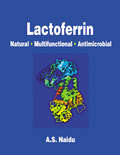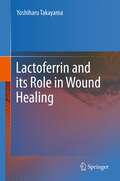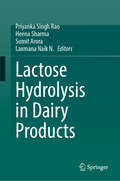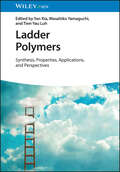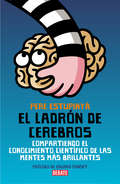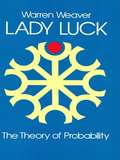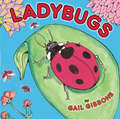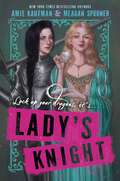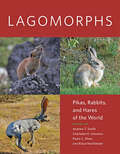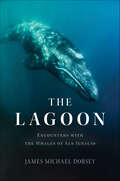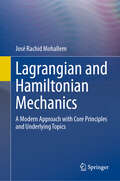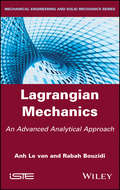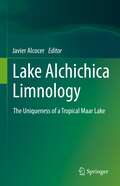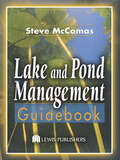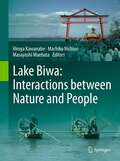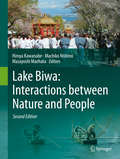- Table View
- List View
Lactoferrin: Natural - Multifunctional - Antimicrobial
by Narian NaiduRecently, researchers found that lactoferrin, when activated, functions as a potent antimicrobial intervention. It protects food by removing harmful bacteria from the surface and by starving bacteria before they can multiply and produce harmful toxins; it also prevents bacteria from re-attaching to food surfaces. As a result this substance has potential to help the agribusiness and food industry supply safer food products to consumers. Lactoferrin: Natural - Multifunctional - Antimicrobial details microbial blocking technology to protect foods from harmful microbes and presents the scientific background on use of this naturally occurring microbial blocking agent as an effective food antimicrobial intervention.
Lactoferrin and its Role in Wound Healing
by Yoshiharu TakayamaLactoferrin is an iron-binding glycoprotein belonging to the transferrin family. It acts as a defense in host animals against microbes and viruses, since it has a broad spectrum of antimicrobial and antiviral activities. Lactoferrin has been shown to regulate the growth and differentiation of many types of cells. The results of recent studies indicate that lactoferrin is a potent regulator of dermal fibroblasts, and promotes cutaneous wound healing. The collagen gel contraction, a model of wound contraction during wound healing process, and migration of human fibroblasts were enhanced by lactoferrin. LRP-1 (LDL Receptor related Protein-1) acts as a signaling receptor for lactoferrin that mediate fibroblast response to lactoferrin by activating ERK/MAPK signaling pathway. In addition, lactoferrin promotes biosynthesis of extracellular matrix (ECM) component such as type-I collagen and hyaluronan. Hyaluronan is a major component of ECM in connective tissue and promotes wound healing. The promoting effect of lactoferrin on hyaluronan production was accompanied by promotion of HAS2 (hyaluronan synthase 2) expression. These observations suggest that lactoferrin promotes the wound healing by providing an ECM that promotes fibroblast migration. Lactoferrin is also known for its anti-inflammatory and immune modulating properties. According to recent in vivo study, lactoferrin promotes wound repair by promoting the early inflammatory phase of wound healing. Based on this, recombinant human lactoferrin was subsequently tested clinically in a Phase II trial in patients with diabetic ulcers and was found to be effective. Lactoferrin should be further evaluated in patients with diabetic and other types of ulcers.
The Lactoperoxidase System: Chemistry and Biological Significance
by Kenneth PruittThis book reviews the major biochemical and biological properties of the lactoperoxidase system including both the bovine milk and human salivary enzymes. It focuses on the basic chemistry of peroxidase-catalyzed reactions and clinical applications of peroxide system antimicrobial effects.
Lactose Hydrolysis in Dairy Products
by Priyanka Singh Rao Heena Sharma Sumit Arora Laxmana Naik N.Lactose is the major disaccharide present in milk. Metabolism of lactose requires lactase which is present in the brush border of epithelial cells of the small intestine. Deficiency of this enzyme leads to malabsorption of lactose and fermentation of lactose occurs in gut which results in various gastrointestinal disorders. Around 70% of the world population suffers from lactose intolerance. Such individuals face difficulty in consumption of milk and milk products. This has led to a great demand in market for the milk products which are either low in lactose or lactose free. Major advances have been made in the production of lactose-free dairy products through lactose hydrolysis processing methods. Most of the books available on lactose hydrolysis in dairy products were published from 1970-1990. Awareness on lactose intolerance has increased in past one decade and development of new strategies to address this issue are progressing at rapid rate. There is a great need for consolidated information representing all aspects of lactose hydrolyzed dairy products. Lactose Hydrolysis in Dairy Products addresses the significance and application of lactose hydrolyzed products from production to consumption. It mainly emphasizes the basic principles that are essential to understand the concept of lactose intolerance and the various processes utilized for production of lactose-free dairy foods. Methods such as enzymatic hydrolysis, membrane processing and fermentation are covered in full. Further coverage includes alternative approaches to combat lactose intolerance, conversion of lactose to other bioactive derivatives and their health effects and the regulatory aspects and the main challenges and potential solutions for the production of lactose hydrolyzed products.
Ladder Polymers: Synthesis, Properties, Applications and Perspectives
by Yan Xia Masahiko Yamaguchi Tien-Yau LuhLadder Polymers An essential reference covering the latest research on ladder polymers Ladder polymers are a unique macromolecular architecture, consisting of a continuous strand of fused rings in their backbones. Such distinctive structures lead to a range of interesting thermal, optical, and electronic properties and self-assembly behaviors, which have been explored for various applications. The book Ladder Polymers: Synthesis, Properties, Applications, and Perspectives presents a collection of diverse topics in ladder polymers consisting of historical overview, state-of-the-art research and development, and potential future directions, written by leading researchers in the related fields. The topics include: Conjugated ladder polymers and graphene nanoribbons Nonconjugated microporous ladder polymers or polymers of intrinsic microporosity Covalent double-stranded polymersSupramolecular double-helical polymers and oligomers Two dimensional polymers This book is a one-stop resource on all the critical research developments in the subject of ladder polymers for broad readership including organic, polymer, and physical chemists, materials scientists and engineers, and chemical engineers.
El ladrón de cerebros: Compartiendo el conocimiento científico de las mentes más brillantes
by Pere EstupinyàUna excitante radiografía de los temas más candentes de la ciencia en la actualidad. La ciencia es la aventura más apasionante que puedas emprender. En El ladrón de cerebros, Pere Estupinyà se infiltra en los principales laboratorios y centros de investigación del mundo con el objetivo de robar el conocimiento de los verdaderos héroes del siglo XXI -los científicos- y compartirlo con sus lectores. Así, a través de las amenas historias de este libro, terminarás familiarizado con los debates más candentes en neurociencia, cosmología, genética, psicología humana o cambio climático. Pero, además, el ladrón de cerebros también rastreará el recorrido de un virus de resfriado por su cuerpo, se introducirá en un escáner cerebral para ver si es capaz de detectar sus propias mentiras, hurgará en las fricciones de la ciencia con la religión y el creacionismo, le pedirá a sus hormonas que le expliquen por qué se enamora, se rendirá a los pies de la teoría del caos, comprobará lo desastroso que es el cerebro tomando decisiones meditadas, entenderá por qué las pupilas de la mujer se dilatan en pleno orgasmo, buscará el origen de las supersticiones, analizará por qué revistas como Science o Nature contienen más errores que otras consideradas inferiores, sabrá los motivos que llevan a un científico entrañable a continuar investigando hasta los noventa y seis años, se volverá loco intentando comprender qué diantre son la antimateria o el entrelazamiento cuántico, y observará sobrecogido gusanos de ocho cabezas, ratas que corren sólo si una luz azul activa sus neuronas, electricidad que fluye sin cables y células de la piel reprogramadas a cardíacas. ¡Disfruta de la ciencia que El ladrón de cerebros ha robado para ti!
El ladrón de cerebros
by Pere EstupinyàLa ciencia es la aventura más apasionante que puedas emprender.En El ladrón de cerebros, Pere Estupinyà se infiltra en los principales laboratorios y centros de investigación del mundo con el objetivo de robar el conocimiento de los verdaderos héroes del siglo XXI -los científicos- y compartirlo con sus lectores.Así, a través de las amenas historias de este libro terminarás familiarizado con los debates más candentes en neurociencia, cosmología, genética, psicología humana o cambio climático.Pero, además, el ladrón de cerebros también rastreará el recorrido de un virus de resfriado por su cuerpo, se introducirá en un escáner cerebral para ver si es capaz de detectar sus propias mentiras, hurgará en las fricciones de la ciencia con la religión y el creacionismo, le pedirá a sus hormonas que le expliquen por qué se enamora, se rendirá a los pies de la teoría del caos, comprobará lo desastroso que es el cerebro tomando decisiones meditadas, entenderá por qué las pupilas de la mujer se dilatan en pleno orgasmo, buscará el origen de las supersticiones, analizará por qué revistas como Science o Nature contienen más errores que otras consideradas inferiores, sabrá los motivos que llevan a un científico entrañable a continuar investigando hasta los noventa y seis años, se volverá loco intentando comprender qué diantre son la antimateria o el entrelazamiento cuántico, y observará sobrecogido gusanos de ocho cabezas, ratas que corren sólo cuando luz azul activa sus neuronas, electricidad que fluye sin cables y células de la piel reprogramadas a cardíacas.¡Disfruta de la ciencia que El ladrón de cerebros ha robado para ti!
El ladrón de cerebros. Comer cerezas con los ojos cerrados
by Pere EstupinyàEl ladrón de cerebros ataca de nuevo para divulgar los conocimientos científicos de las mentes más brillantes de la actualidad. Los avances científicos se suceden a un ritmo vertiginoso, y cada vez son más las personas interesadas en conocer y entender cómo funciona el mundo, conscientes de que el conocimiento científico nos ayuda a vivir mejor y a tomar mejores decisiones en nuestro día a día. Pere Estupinyà, el ladrón de cerebros, ataca de nuevo y busca las mentes más brillantes para poner sus conocimientos a disposición de todos. Nos interesa saber de dónde venimos y cuál es nuestro lugar en el universo, pero también queremos entender hacia dónde vamos. El ladrón de cerebros nos recuerda que una predisposición a aprender, a reflexionar y a absorber nuevas ideas nos hace más inteligentes como sociedad y como individuos: el pensamiento crítico es fundamental para nuestras vidas y la ciencia, su mejor expresión. Reseña:«Rebosante de empirismo científico y de datos que llevarnos a nuestras vidas cotidianas. E incluso sobre la felicidad. » La Vanguardia
Lady Luck: The Theory of Probability
by Warren Weaver"Should I take my umbrella?" "Should I buy insurance?" "Which horse should I bet on?" Every day - in business, in love affairs, in forecasting the weather or the stock market questions arise which cannot be answered by a simple "yes" or "no." Many of these questions involve probability. Probabilistic thinking is as crucially important in ordinary affairs as it is in the most abstruse realms of science. This book is the best nontechnical introduction to probability ever written. Its author, the late Dr. Warren Weaver, was a professor of mathematics, active in the Rockefeller and Sloan foundations , an authority on communications and probability, and distinguished for his work at bridging the gap between science and the average citizen. In accessible language and drawing upon the widely diverse writings of thinkers like Kurt Godel, Susanne K.Langer, and Nicholas Bernoulli, Dr. Weaver explains such concepts as permutations, independent events, mathematical expectation, the law of averages, Chebychev's theorem, the law of large numbers, and probability distributions. He uses a probabilistic viewpoint to illuminate such matters as rare events and coincidences, and also devotes space to the relations of probability and statistics, gambling, and modern scientific research. Dr. Weaver writes with wit, charm and exceptional clarity. His mathematics is elementary, grasp of the subject profound, and examples fascinating. They are complemented by 49 delightful drawings by Peg Hosford. 13 tables. 49 drawings. Foreword. Index.
Ladybug Life Cycle
by Justin Mccory MartinLearn how ladybugs grow from tiny eggs into shiny, colorful insects in this Science Vocabulary Reader. This book is part of a series of books for early readers about the life cycles of different animals.
Ladybugs
by Gail GibbonsEverything you ever wanted to know about ladybugs— and why they're crucial to our environment. When you think of a ladybug, you might picture a little red beetle with seven black spots on its back—but did you know there are thousands of types of ladybugs, spread across the world? With her signature combination of simple text, clear illustrations, and simple diagrams, Gail Gibbons explores the world of ladybugs. These small beetles live on six of the seven continents, ranging in size, markings, and coloration. Follow a ladybug through the four stages of its development from egg to adult, and learn about its behavior and habitat—plus, how little ladybugs help protect crops by eating harmful insects. Bright illustrations and an easy-to-read text make this ideal for young readers studying the natural world. A page of quick ladybug facts and resources for learning more are included.
Ladybugs
by Monica HughesThis book identifies the main physical features of bug including what they eat, how they change, and how they reproduce.
Lady's Knight
by Amie Kaufman Meagan SpoonerAn undeniably fierce, unforgettably funny, unapologetically queer feminist romp through the England of medieval legend. Bestselling and acclaimed authors Amie Kaufman and Meagan Spooner bring readers along on an epic quest for valor, freedom, and, above all, love. A Knight’s Tale meets the Lady Jane series, with a dash of The Great!Gwen is sick of hiding—hiding the fact that she’s taken over her father’s blacksmithing duties, hiding her attraction to girls, hiding her yearning for glory as a knight.Meanwhile, Lady Isobelle of Avington, queen bee of the castle, has never once considered hiding who she is—until now. She’s been chosen as the grand prize in the Tournament of Dragonslayers, to be given to whichever knight can claim her hand. And for the first time in her life, she can’t talk her way out of trouble.When Isobelle discovers Gwen’s knightly ambitions, they hatch a scheme together—Gwen will joust in the tournament, disguised as Sir Gawain. Winning means freedom for Isobelle, and glory for Gwen. Losing means… well, let’s not go there.One thing’s for sure: Falling in love was never the plan.But the best laid plans…are often trampled all over by dragons."A sapphic delight, full of jousts, jaunts, and courtly love. Lady's Knight sparkles with wit and charm and has lady knights to swoon over. Kaufman and Spooner will leave you breathless." —C. S. Pacat, New York Times bestselling author of Dark Rise“Kaufman and Spooner are auto-buy authors for me, always guaranteed to get my heart pumping with their page-turning romance and high-stakes adventure.” —New York Times bestselling author Susan Dennard"There are a lot of damsels in Lady's Knight, but none of them need a man to fix their problems. (Men seem to be the source of the problems, in fact.) Wholesome, heartfelt, and more fun than cheesecake on a stick, Kaufman and Spooner's latest book is all about women's work. You know, jousting, dragonslaying, and saving the kingdom—all while looking fabulous." —Jodi Meadows, coauthor of the New York Times bestselling novels My Lady Jane and My Plain Jane“Clever, funny, thrilling, and romantic—Lady’s Knight will inspire readers to take up their swords to fight dragons and the patriarchy. Perfect for fans of A Knight’s Tale and anyone who loves a romantasy with wit, charm, and the occasional comedic fourth wall break.” —F. T. Lukens, New York Times bestselling author of So This Is Ever After"You'll laugh, you'll cry, and you'll be ready to fight any dragon after reading this delightful tale full of swoony romance, heart-racing action, and the very best banter in the realm!" —Beth Revis, New York Times bestselling coauthor of Night of the Witch"Writing that is above all else marvelously warm and at the same time witty, adventure and romance that will sweep you off your feet—a double sweep, and a triumph!" —Sarah Rees Brennan, #1 Sunday Times bestselling author of Long Live Evil"Sparkles with wit and romance! So many quotable lines. Not to mention the sexiest gown-lacing scene in modern literature. Like its characters, Lady's Knight is endlessly clever and resourceful." —Ellen Kushner, award-winning author of Swordspoint
Lagoa Santa Karst: Brazil's Iconic Karst Region (Cave and Karst Systems of the World)
by Augusto S. Auler Paulo PessoaThis book discusses the Lagoa Santa Karst, which has been internationally known since the pioneering studies of the Danish naturalist Peter Lund in the early 1800s. It covers the speleogenesis, geology, vegetation, fauna, hydrogeology, geomorphology, and anthropogenic use of the Lagoa Santa Karst and is the first English-language book on this major karst area. The area, which has been at the heart of the debate on the origin and age of human colonization in the Americas, is characterized by a classical and scenic karst landscape with limestone cliffs, karst lakes and karst plains, in addition to numerous solution dolines. More than 1,000 caves have been documented in the area, many with significant archeological and paleontological value. Despite its great importance, the Lagoa Santa Karst faces severe environmental threats due to limestone mining and the expansion of the metropolis of Belo Horizonte and its surrounding towns. The growing recognition of the area’s remarkable significance has led to increasing concern, and a number of protected areas have now been established, improving the conservation status of this landmark karst area.
Lagomorphs: Pikas, Rabbits, and Hares of the World
by Andrew T. Smith; Charlotte H. Johnston; Paulo C. Alves; Klaus HackländerThe definitive guide to all lagomorphs—pikas, rabbits, and hares.Numbering 92 species worldwide, members of the order Lagomorpha are familiar to people throughout the world, and yet their remarkable diversity and ecological importance are often underappreciated. In this book, Andrew T. Smith and his colleagues bring together the world’s lagomorph experts to produce the most comprehensive reference on the order ever published, featuring detailed species accounts, stunning color photos, and up-to-date range maps. Contributors highlight the key ecological roles that lagomorphs play and explain in depth how scientists around the globe are working to save vulnerable populations.Thematic introductory chapters cover a broad spectrum of information about pikas, rabbits, and hares, from evolution and systematics to diseases and conservation. Each animal account begins with the complete scientific and common names for the species, followed by a detailed description of appearance and unique morphological characteristics, including a range of standard measurements of adult specimens. Subsequent sections discuss known paleontological data concerning the species, the current state of its taxonomy, and geographic variation. Each account also includes dedicated sectioins on habitat and diet, reproduction and development, ecology, behavior, and management. The definitive work on lagomorphs, this book is an invaluable reference for naturalists, professional biologists, and students. It will also be beneficial for those conducting biodiversity surveys and conservation throughout the world.
The Lagoon: Encounters with the Whales of San Ignacio
by James Michael DorseyA voyage to a magical marine haven, the San Ignacio Lagoon in Baja, Mexico, where the connection between man and beast is like no other on Earth. Once a killing ground for whalers hunting a leviathan they called the “devilfish,” the San Ignacio Lagoon in Baja, Mexico, is now an environmental and spiritual sanctuary—the only place in the world where animals in their natural aquatic environment routinely seek out human contact. A nursery for the gray whale since before recorded history, the lagoon and its stories, told here by resident naturalist James Michael Dorsey, illuminate the magic of human connection to animals, and what those bonds teach us about ourselves and our purpose on this shared planet. Weaving two decades of San Ignacio adventures in the company of his wife Irene with the fascinating history of the lagoon, Dorsey vividly captures the lively people of Baja, like the mystical godfather of whale-watching, Pachico Mayoral, as well as the whales he’s bonded with over the years, like Slackjaw, Patch, and Dervish—their individual personalities, their epic migration to and from the Pacific Northwest, and the science behind their behavior. Looming over his journeys are the many dangers to the area, from the Mitsubishi Corporation’s attempts to build salt works to plans for resort development on the Baja coast, to pollution and climate change, and even to the orcas who hunt the gray whales. The future of this refuge has never looked more threatened. A tale of wondrous bonds between the intelligent, spirited gray whales and the men, women, and children from around the world who come to this place to touch, kiss, and play with them—The Lagoon is a testament to the importance of preserving these animals and their natural habitats.
The Lagoon: How Aristotle Invented Science
by Armand Marie LeroiA brilliant study of Aristotle as biologist The philosophical classics of Aristotle loom large over the history of Western thought, but the subject he most loved was biology. He wrote vast volumes about animals. He described them, classified them, told us where and how they live and how they develop in the womb or in the egg. He founded a science. It can even be said that he founded science itself. In The Lagoon, acclaimed biologist Armand Marie Leroi recovers Aristotle&’s science. He revisits Aristotle&’s writings and the places where he worked. He goes to the eastern Aegean island of Lesbos to see the creatures that Aristotle saw, where he saw them. He explores Aristotle&’s observations, his deep ideas, his inspired guesses—and the things he got wildly wrong. He shows how Aristotle&’s science is deeply intertwined with his philosophical system and reveals that he was not only the first biologist, but also one of the greatest. The Lagoon is both a travelogue and a study of the origins of science. And it shows how a philosopher who lived almost two millennia ago still has so much to teach us today.
Lagrangian and Hamiltonian Analytical Mechanics: Forty Exercises Resolved and Explained (UNITEXT for Physics)
by Vladimir PletserThis textbook introduces readers to the detailed and methodical resolution of classical and more recent problems in analytical mechanics. This valuable learning tool includes worked examples and 40 exercises with step-by-step solutions, carefully chosen for their importance in classical, celestial and quantum mechanics. The collection comprises six chapters, offering essential exercises on: (1) Lagrange Equations; (2) Hamilton Equations; (3) the First Integral and Variational Principle; (4) Canonical Transformations; (5) Hamilton – Jacobi Equations; and (6) Phase Integral and Angular FrequenciesEach chapter begins with a brief theoretical review before presenting the clearly solved exercises. The last two chapters are of particular interest, because of the importance and flexibility of the Hamilton-Jacobi method in solving many mechanical problems in classical mechanics, as well as quantum and celestial mechanics.Above all, the book provides students and teachers alike with detailed, point-by-point and step-by-step solutions of exercises in Lagrangian and Hamiltonian mechanics, which are central to most problems in classical physics, astronomy, celestial mechanics and quantum physics.
Lagrangian and Hamiltonian Mechanics: A Modern Approach with Core Principles and Underlying Topics
by José Rachid MohallemThis book serves as a textbook for an analytical mechanics course, a fundamental subject of physics, that pays special attention to important topics that are not discussed in most standard textbooks. Readers are provided with a clear understanding of topics that are usually inaccessible to the undergraduate level and that are critical to learning Lagrangian and Hamiltonian mechanics. Each chapter also includes worked problems and solutions, as well as additional exercises for readers to try. This book begins with the fundamentals of analytical mechanics, concisely introducing readers to the calculus of variations, Hamilton’s Principle, and Lagrange’s equations. While presenting readers with these core topics, the author uses an intuitive approach to delve into essential questions, such as where Galilean invariance lies in Lagrangian mechanics and how Hamilton’s Principle of Least Action encompasses Newton’s three laws, interesting conclusions that often go unnoticed. Infact, Hamilton’s principle is taken throughout as the very origin of classical physical laws, and the choice of appropriate Lagrangians in each case as the real theoretical challenge, meaning that forms of Lagrangian which differ from the standard one are not mere curiosities but, instead, the general rule. This book clarifies common misunderstandings that students face when learning the subject and formally rationalizes concepts that are often difficult to grasp. In addition, the final chapter provides an introduction to a Lagrangian field theory for those interested in learning more advanced topics. Ideal for upper undergraduate and graduate students, this book seeks to teach the intrinsic meaning of the principles and equations taught in an analytical mechanics course and convey their usefulness as powerful theoretical instruments of modern physics.
Lagrangian Interaction: An Introduction To Relativistic Symmetry In Electrodynamics And Gravitation
by Noel DoughtyThis book is an introduction to Lagrangian mechanics, starting with Newtonian physics and proceeding to topics such as relativistic Lagrangian fields and Lagrangians in General Relativity, electrodynamics, Gauge theory, and relativistic gravitation. The mathematical notation used is introduced and explained as the book progresses, so it can be understood by students at the undergraduate level in physics or applied mathmatics, yet it is rigorous enough to serve as an introduction to the mathematics and concepts required for courses in relativistic quantum field theory and general relativity.
Lagrangian Mechanics: An Advanced Analytical Approach
by Anh Le Van Rabah BouzidiLagrangian Mechanics explains the subtleties of analytical mechanics and its applications in rigid body mechanics. The authors demonstrate the primordial role of parameterization, which conditions the equations and thus the information obtained; the essential notions of virtual kinematics, such as the virtual derivative and the dependence of the virtual quantities with respect to a reference frame; and the key concept of perfect joints and their intrinsic character, namely the invariance of the fields of compatible virtual velocities with respect to the parameterization. Throughout the book, any demonstrated results are stated with the respective hypotheses, clearly indicating the applicability conditions for the results to be ready for use. Numerous examples accompany the text, facilitating the understanding of the calculation mechanisms. The book is mainly intended for Bachelor's, Master's or engineering students who are interested in an in-depth study of analytical mechanics and its applications.
Lake Alchichica Limnology: The Uniqueness of a Tropical Maar Lake
by Javier AlcocerThe book provides a comprehensive account of a tropical lake, Alchichica, considering that tropical limnology is by far less known and well-understood than temperate. Many of the well-known temperate limnology paradigms do not apply in tropical limnology, such as the ≥ 1ºC/m thermocline concept, or the role of phosphorous as a limiting nutrient. Lake Alchichica is - most likely – the best limnologically known Mexican lake up to date. Twenty years of continuous monitoring has led us to understand this deep, warm monomictic lake. The peculiar chemical composition of this saline lake – sodium-alkaline with a high concentration in magnesium waters, and groundwater-fed – led to the formation of its unique stromatolite ring that has become world-famous, studied by scientists from various countries. From a biological point of view, this relatively small maar lake displays a comparatively low species richness but surprisingly is plentiful in microendemic species for a recently-formed lake (13,000-6,300 years old, at the Late Pleistocene/Holocene Epoch), eleven of which already described, with more to come. Researchers and students interested in tropical limnology, extreme ecosystems, evolutionary biology, astrobiology, and microbiology will find this book a must-read.
Lake and Pond Management Guidebook
by Steve McComasThe Lake and Pond Management Guidebook is the successor to the bestselling Lake Smarts: The First Lake Maintenance Handbook, the "bible" for small-scale lake and pond improvements, published by the Terrene Institute in 1993. Completely revised and updated, now published by Lewis Publishers, this guidebook contains over 300 ideas and projects includ
Lake Biwa: Interactions between Nature and People
by Hiroya Kawanabe Machiko Nishino Masayoshi MaehataThis book focuses on the long-term interactions between people and nature in and around Lake Biwa, one of the oldest lakes in the world. Accordingly, it not only covers the characteristics of the biota of this ancient lake, but also approaches it as a 'cultural ancient lake.' Furthermore, various problems affecting the lake, especially recent environmental changes that occurred before and after Japan's rapid economic growth of the 1950s and 60s, are reviewed, including water pollution, lakeshore development and the reclamation of attached lakes, alien and invasive species, and problems related to the recent warming of the climate. Lastly, by analyzing data on these problems collected by the local government and residents of the lake basin, the book provides a comprehensive outlook on the future of Lake Biwa and people's lifestyles. As such, it provides indispensable information for all people engaged in improving and conserving water regimes around the world, as well as people interested in the culture and history of Japan.
Lake Biwa: Second Edition
by Hiroya Kawanabe Machiko Nishino Masayoshi MaehataAlthough, the first edition had a similar focus, more than five years have passed since its publication and the biological and social circumstances of the lake have drastically changed due to, for example, the further expansion of alien species, the decrease of indigenous species, the progress of integrated watershed management by the Union of the Kansai Government which was established in 2010, the legislation of the Conservation and Restoration Act of Lake Biwa in 2015 and more. The new edition will therefore feature updated and new information on the above and more topics as well as updated and revised data based on the latest research. Inventories of respective taxa, especially those of small animals, are also revised based on the latest studies. Furthermore, this volume covers the characteristics of the biota of this ancient lake, but at the same time, it will also approach it as a ‘culture ancient lake’. Other topics also include water pollution, lakeshore development, the effects of global warming in the past and present, the influence of people, and countermeasures by local and national governments. Moreover, the volume also provides a comprehensive view on the future of Lake Biwa and that of its residents. Miraculously enough, this ancient lake has kept its water quality clear even until today despite the fact of more than 1.4 million people living on its shores. Finally, the book also gives indispensable information to those engaged in improving and conserving water regimes of lakes and other water bodies all over the world and to those interested in the culture and history of Japan. Lake Biwa is not only one of the rarest ancient lakes of the world, but the people’s involvement with the lake also goes back a long way. This is shown in the diverse culture developed in this area and in the various archaeological finds that date back as early as the Jomon Period, nearly 10.000 years ago. Today Lake Biwa fulfills an important role as a water resource by providing domestic, commercial, industrial, and agricultural water for over 14 million residents living around the Lake Biwa-Yodo River drainage basin. This updated volume focuses on the geological and biological features of the lake as well as on the long-term interactions between the people and the lake.
